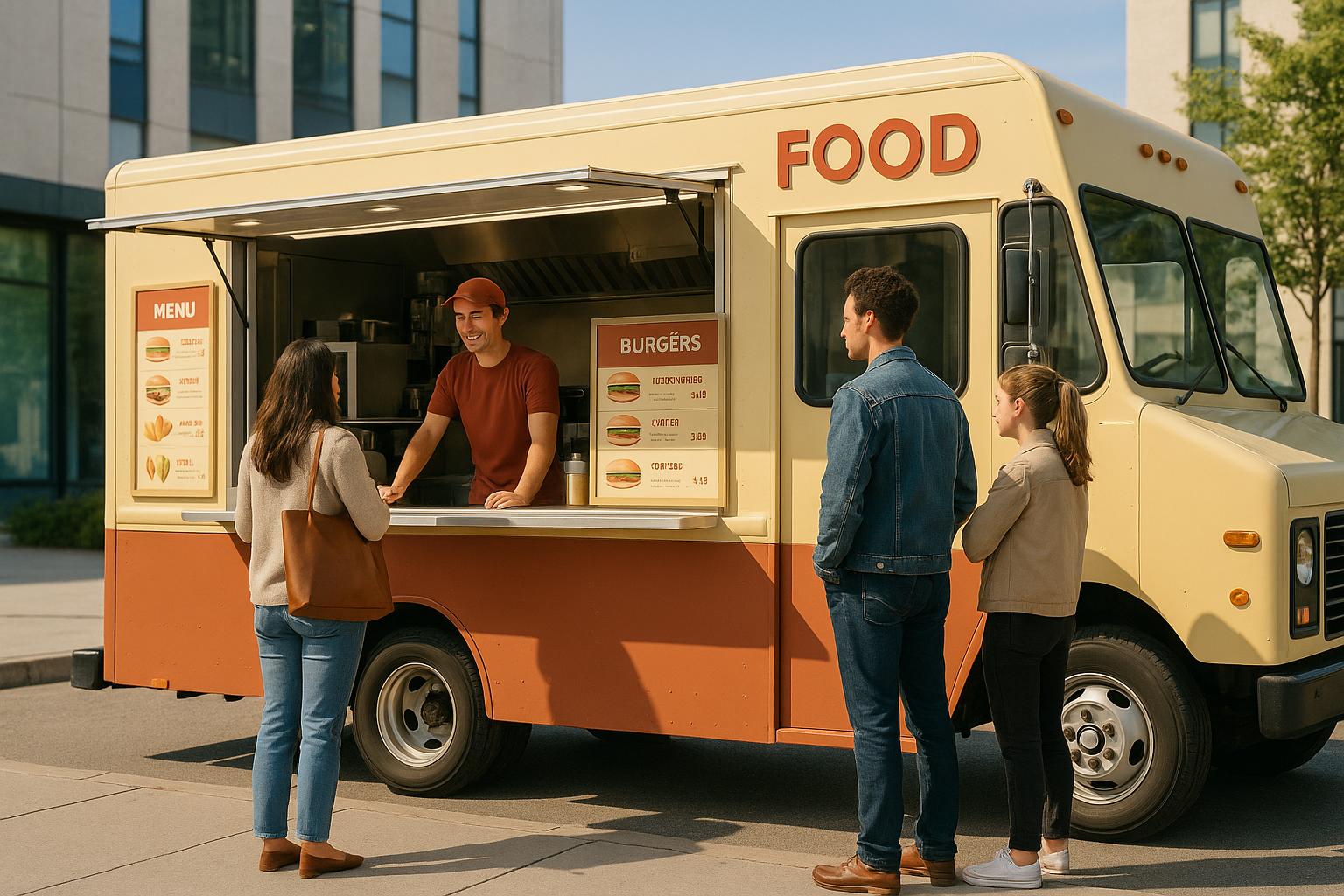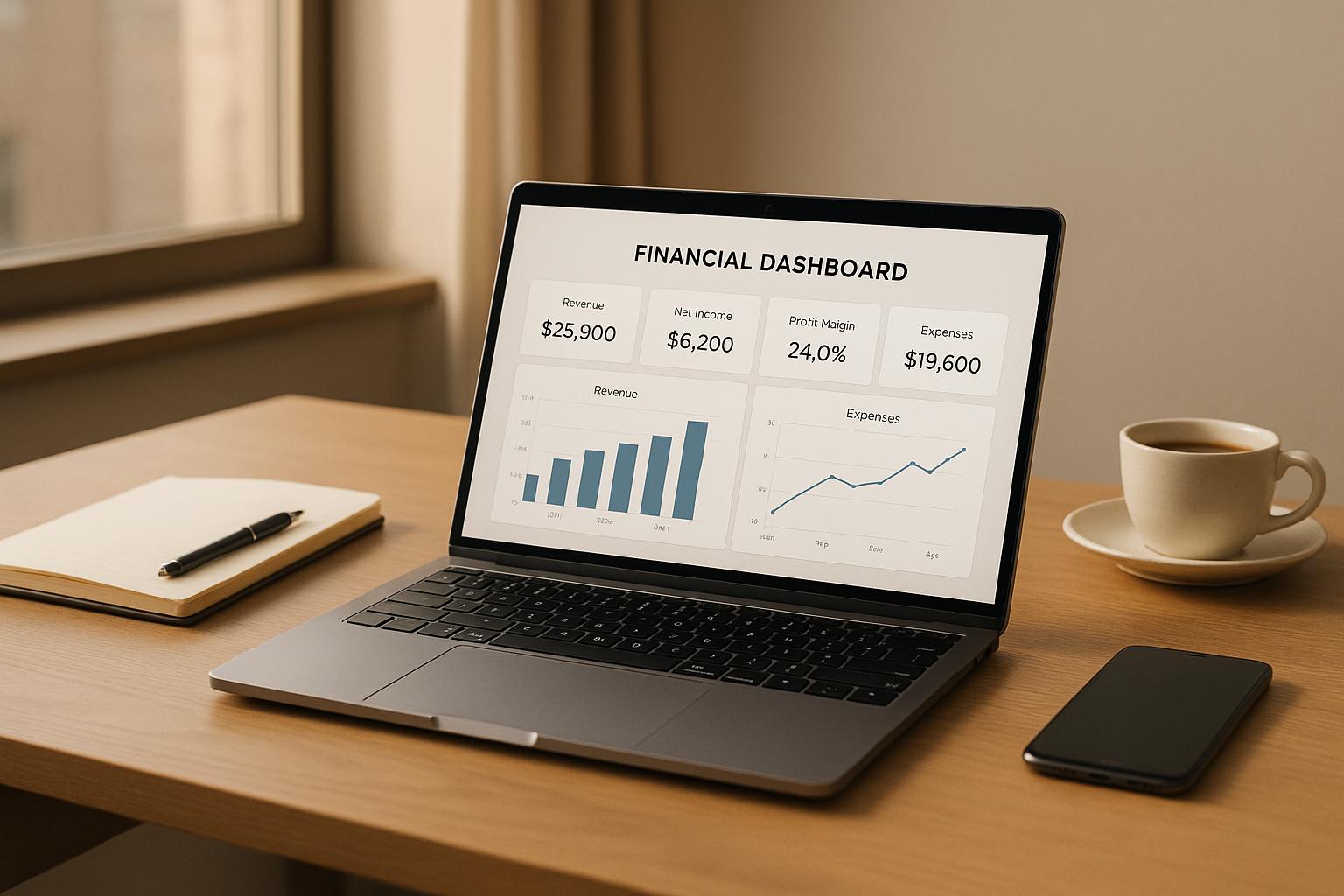
Starting a food truck in 2025 requires an upfront investment ranging from $100,000 to $250,000, with costs driven higher by inflation and supply chain challenges. The main expenses include the vehicle, kitchen setup, permits, and branding. Here's a quick breakdown:
- Vehicle Options:
- New trucks: $75,000–$200,000
- Used trucks: $50,000–$100,000
- Used chassis with new kitchen: $85,000–$115,000
- Leasing: $2,000–$3,000/month
- Kitchen Equipment: $20,000–$50,000 for appliances, refrigeration, ventilation, and POS systems.
- Permits & Licensing: $1,000–$3,000 for basic permits, but some cities may charge up to $28,276 for first-year compliance.
- Branding: $2,000–$10,000 for logo design, vehicle wraps, and signage.
Monthly operating costs include fuel, inventory, labor, insurance, and commissary kitchen fees. Managing seasonal changes and monitoring profit margins is critical for success. Tools like POS systems and inventory software can help streamline expenses and improve profitability.
Launching a food truck takes careful planning, but understanding these costs upfront can help you build a sustainable business.
Master the Ultimate Food Truck Budget Plan! [ 6 STEPS TO PROFITABLE PLAN ]
Food Truck Startup Costs Breakdown
Starting a food truck business involves several key expenses: the vehicle, kitchen setup, and branding. Below, we’ll dive into the costs associated with each.
Vehicle Purchase, Lease, or Retrofit
Your food truck is the foundation of your business, and there are several ways to acquire one:
- Buying a new food truck: This option costs between $75,000 and $200,000. New trucks come equipped with the latest technology and require minimal maintenance, but they demand a significant upfront investment and may take months to customize before you can start serving.
- Used food trucks: These typically range from $50,000 to $100,000. While they’re more affordable initially, you might need to budget for repairs or upgrades, so a thorough inspection is essential.
- Used chassis with a new kitchen: Combining a used truck body with a custom kitchen installation costs between $85,000 and $115,000. This option balances affordability with the ability to tailor the kitchen to your needs.
- Leasing: Leasing a truck costs about $2,000 to $3,000 per month. This approach is ideal for testing your concept with less financial risk upfront.
| Option | Cost Range | Ideal For | Key Advantage |
|---|---|---|---|
| New Food Truck | $75,000–$200,000 | Those needing reliability | Latest technology and full customization |
| Used Food Truck | $50,000–$100,000 | Budget-conscious operators | Lower upfront costs and quicker startup |
| Used Chassis + New Kitchen | $85,000–$115,000 | Balanced customization seekers | Affordability with personalization |
| Leasing | $2,000–$3,000/month | Market testing | Immediate start with low upfront cost |
Kitchen Equipment and Fit-Out Costs
Your kitchen setup dictates not only what you can cook but also how efficiently you can serve customers. Fit-out costs typically range from $20,000 to $50,000, depending on your menu and the quality of the equipment.
- Cooking appliances: Expect to spend $5,000 to $20,000. The exact cost depends on your menu; a truck specializing in sandwiches will need less equipment than one offering a diverse menu.
- Refrigeration systems: Essential for food safety, these systems cost between $2,000 and $8,000. They provide cold storage for ingredients, prepared foods, and drinks.
- Ventilation systems: Ranging from $1,000 to $5,000, these systems are crucial for removing smoke, grease, and odors, ensuring a safe work environment.
- Point-of-sale (POS) systems: Modern POS systems, which streamline transactions and inventory management, cost between $500 and $2,000.
To save money, consider buying used or refurbished equipment from trusted suppliers, attending restaurant auctions, or negotiating bulk discounts. These strategies can help you reduce costs by up to 30% without sacrificing safety or efficiency.
Branding and Visual Design
A strong brand is essential for standing out and creating a lasting impression. Branding costs typically range from $2,000 to $10,000, covering everything from logo design to vehicle wraps.
- Vehicle wraps: Costing between $2,500 and $7,000, wraps transform your truck into a mobile advertisement. High-quality wraps are weather-resistant and feature eye-catching designs.
- Signage: Add another $500 to $2,000 for menu boards, window decals, and other exterior displays. Clear signage helps customers quickly understand your offerings, especially during busy times.
- Logo design: A professional logo costs between $500 and $1,500. A well-designed logo enhances brand recognition and can be used across all marketing materials.
Investing in professional branding not only boosts your truck’s visibility but also builds trust and loyalty among customers. In competitive markets, a polished and cohesive brand can make all the difference in attracting and retaining a loyal customer base.
Licensing, Permits, and Compliance Fees
Running a food truck involves navigating a maze of permits and licenses, which significantly influence both startup and ongoing expenses. These requirements are designed to uphold food safety and ensure businesses operate within legal guidelines, but they vary widely depending on your location.
Required Licenses and Permits
To get your food truck rolling, you'll need several key permits and licenses:
- Business License: This grants you the legal right to operate and comes with fees that differ by city or county.
- Health Department Permit: Ensures your food handling and preparation meet safety standards, typically verified through regular inspections.
- Sales Tax Permit: Required in most areas to legally collect and remit sales tax.
- Mobile Vending Permit: Allows you to sell food in public spaces.
- Workers' Compensation Insurance: Necessary if you hire employees.
- Reseller's Permit: May be required to buy ingredients tax-free, depending on your state.
Each of these permits plays a specific role in keeping your business compliant with local laws and regulations.
Fire, Safety, and Parking Compliance
Food trucks must also adhere to strict fire and safety standards. This usually means installing fire suppression systems, keeping fire extinguishers on hand, and obtaining fire department permits. Emergency exits and proper ventilation systems are also mandatory to meet safety codes.
Parking can be another hurdle. Many cities issue special parking permits for food trucks, which might be valid for a single day or an entire year. Fees for these permits often depend on location and demand, with prime spots in busy areas costing more. Additionally, compliance with the Americans with Disabilities Act (ADA) could mean making adjustments to your serving area, potentially adding to your expenses.
State and Local Variations
Permit costs and regulations can differ drastically depending on where you operate. Urban areas, for instance, often have higher fees and stricter rules compared to rural locations. In larger cities, the combined costs of permits from multiple agencies can add up quickly.
In some states, you might also need a commissary agreement. This means using a licensed commercial kitchen for food storage or preparation, which comes with ongoing monthly fees. On the other hand, areas with fewer regulations might offer a more affordable path to compliance.
Before you dive in, thoroughly research the local requirements and costs in your area. Being prepared can save you from unexpected expenses and ensure a smooth launch for your food truck business.
sbb-itb-08dd11e
Monthly Operating Expenses
Once your food truck is up and running, keeping a firm handle on monthly expenses becomes essential for maintaining profitability. These costs directly influence your bottom line, so understanding and managing them is key to effective budgeting.
Fixed Monthly Costs
One of the biggest fixed costs for food truck operators is renting a commissary kitchen. These licensed facilities offer essential services like food prep areas, storage space, and dishwashing stations. If you're in a big city, expect to pay more than you would in a smaller town.
Insurance is another fixed expense you can't overlook. Policies typically include general liability and commercial auto coverage, and if you have employees, workers' compensation may also be required. Rates will depend on factors like your location and the specifics of your operation.
Loan payments are another piece of the puzzle. Whether you're paying off the truck itself or financing kitchen equipment, these monthly payments will vary based on your loan amount, interest rate, and repayment terms.
Don't forget about communication services. You'll need reliable systems for your point-of-sale (POS) operations, communication tools, and tracking services, all of which come with recurring costs.
Now, let’s look at the expenses that fluctuate based on your business activity.
Variable Costs
Fuel is a variable cost that depends on your truck’s efficiency, the routes you take, and current gas prices. Food inventory is another major expense, and it’s closely tied to your sales volume and menu complexity. A simple menu can help keep inventory costs down, while more intricate dishes might require specialty ingredients that drive up spending.
Maintenance and repairs are also unpredictable. Newer trucks and equipment usually need just routine servicing, but older vehicles may rack up higher costs due to unexpected breakdowns.
Labor costs will vary depending on your team size. Many food truck owners handle operations themselves in the beginning, but as the business grows, you might need to hire part-time or full-time staff. If you offer benefits or need additional support, these costs can rise significantly.
These variable expenses often shift with your daily operations and can be even more unpredictable during seasonal changes.
Managing Seasonal Changes
Seasonal fluctuations, like slower sales in winter or during rainy periods, can have a big impact on your revenue. Planning ahead is crucial to navigating these changes. For example, during slower months, you might negotiate lower commissary fees or scale back staffing levels to reduce expenses.
To avoid waste when business slows, focus on your core menu items and work with suppliers to secure flexible terms. Use these quieter periods to tackle maintenance and repairs, spreading those costs over time.
On the flip side, peak seasons may require you to stock up on inventory and hire temporary staff. While these adjustments can increase your expenses, they’re often balanced out by higher sales. Having a cash reserve to cover several months of operating costs can be a smart way to handle seasonal dips and unexpected expenses.
How to Calculate and Improve Profit Margins
Keeping a close eye on your profit margins is crucial for making smarter business decisions and staying profitable. When you focus on margins, you get a clearer picture of your financial health and can make adjustments to keep your business thriving.
Step-by-Step Margin Calculation
To calculate your profit margin, you need three main figures: total revenue, cost of goods sold (COGS), and total operating expenses. The formula is straightforward: subtract your total costs from your revenue, then divide the result by your revenue.
Here’s an example: Let’s say your food truck brings in $8,000 in revenue each month, and your food costs amount to $2,400. Your gross profit would be $5,600, giving you a 70% gross margin. To find your net profit margin, you’d also factor in operating expenses like rent, utilities, and wages.
It’s smart to compare your food and labor costs to standard benchmarks in the industry. If your food costs seem unusually high, it might be time to rethink your pricing strategy or look for more affordable ingredient options. These calculations, paired with industry benchmarks, provide the insights you need to make strategic changes.
Industry Benchmarks and Averages
Profit margins for food trucks can vary widely depending on factors such as location, menu type, and operational efficiency. A food truck in a bustling urban area might take advantage of higher pricing, while one in a smaller or less busy market may face different challenges.
Location is a key factor. Trucks stationed in areas with steady foot traffic - like office parks or college campuses - often enjoy more stable margins. On the other hand, trucks that rely on festivals or special events may experience big swings in profitability between busy and slow seasons.
Menu complexity also plays a big role. A simple menu with high-demand, easy-to-prepare items can help keep costs low and margins healthy. In contrast, offering elaborate dishes with expensive ingredients or time-intensive prep can strain your profits.
Seasonality and weather are additional considerations. Many food trucks perform better during warm months and in busier seasons. During colder or slower periods, you might need to adjust your operations to keep expenses in check with revenue.
Using Tools to Improve Margins
Once you’ve calculated your margins, you can use technology to fine-tune your operations and boost profitability. For instance, point-of-sale (POS) systems can provide detailed analytics on which menu items are most profitable and help identify the best times and locations to operate.
AI-driven tools like IdeaFloat’s business planning software can analyze your cost structure and highlight areas for improvement. Features like financial forecasting make it easier to test different pricing strategies or see how changes in food costs or operational expenses might affect your bottom line.
Inventory management software is another game-changer. It helps you track ingredient usage, reduce waste, and even sends alerts when items are nearing expiration.
Dynamic pricing strategies can also give you a revenue boost. For example, implementing surge pricing during peak hours can increase profits without upsetting your customers.
Finally, regular cost analysis - whether done through spreadsheets or specialized software - can help you spot and address issues before they grow. By keeping an eye on trends and investigating unexpected spikes in expenses, you can protect your margins and maintain a healthy bottom line.
Key Takeaways for Food Truck Entrepreneurs
Starting a food truck business takes careful financial planning to cover both the upfront and ongoing costs. These expenses include everything from buying and outfitting the vehicle to securing permits and managing monthly operating costs. Getting these basics right lays the groundwork for a sustainable operation.
Local licensing requirements can differ significantly, so it’s important to reach out to your local health department and licensing office early in the process. Compliance costs can vary widely depending on where you’re operating and the type of food you’re serving, so understanding these details upfront is crucial.
Keeping an eye on profit margins is essential, especially since food and labor costs often make up a large chunk of your revenue. Regularly reviewing these costs allows you to spot trends and find areas to cut waste or improve efficiency. This kind of proactive management can make a big difference in maintaining profitability.
Using tools like POS systems and inventory management software can help you track which menu items are performing well, reduce waste, and control costs. For those looking to refine their financial planning, platforms like IdeaFloat offer AI-driven insights to help map out costs before committing significant resources.
Where you park your truck and the complexity of your menu can also heavily influence your bottom line. High-traffic locations, such as business hubs or college campuses, might come with higher costs but can generate greater revenue. Similarly, a menu focused on quick-to-prepare, high-margin items can help streamline operations and keep profit margins healthy.
FAQs
How can I manage seasonal changes in the food truck business to stay profitable?
Seasonal shifts can influence food truck sales, but there are smart strategies to keep your profits steady. One approach is to update your menu to feature seasonal ingredients or cozy comfort foods that resonate with colder weather. Another tactic is to adjust your schedule and locations - focus on busy spots or seasonal events like summer festivals or winter holiday markets to capture more foot traffic.
On top of that, seasonal marketing campaigns can make a big difference. Use social media to spotlight limited-time specials, loyalty rewards, or exclusive deals that spark interest and encourage visits. By staying adaptable and planning ahead, you can successfully tackle seasonal challenges and keep your business on track.
What are the key factors to consider when deciding whether to lease or buy a food truck?
Choosing whether to lease or buy a food truck boils down to your budget, long-term plans, and how much flexibility you need. Leasing can be appealing if you’re just stepping into the food truck business or experimenting with the market. The upfront costs are usually lower, which can ease the financial burden. That said, leasing often comes with strings attached - like mileage limits or restrictions on how much you can modify the truck.
On the other hand, buying a food truck - whether brand-new or pre-owned - means a bigger initial investment. But with ownership comes freedom. You can tailor the truck to suit your business exactly how you envision it. If your goal is to keep the truck for the long haul, purchasing it might save you money in the long run.
The key is to weigh your financial situation, business goals, and how much control you want over the truck. Take the time to assess what fits your needs best.
What are the best ways to use tools and technology to boost profit margins in a food truck business?
Using the right tools and technology can make a big difference in boosting profits for your food truck business. Start with a point-of-sale (POS) system. These systems simplify order processing, keep track of sales, and monitor inventory in real time. That means fewer mistakes and smoother operations, especially during those hectic rush hours.
You might also want to explore mobile apps or online platforms for handling orders and payments. Not only do they make things easier for your customers, but they also give you insights into purchasing patterns. With that data, you can tweak your menu or adjust pricing to match customer preferences. And don't overlook the power of social media management tools. They’re great for promoting your truck, engaging with your audience, and drawing more customers to your location.
By leveraging these technologies, you can save valuable time, cut down on waste, and give your profits a healthy boost.
Related Blog Posts
Get the newest tips and tricks of starting your business!


